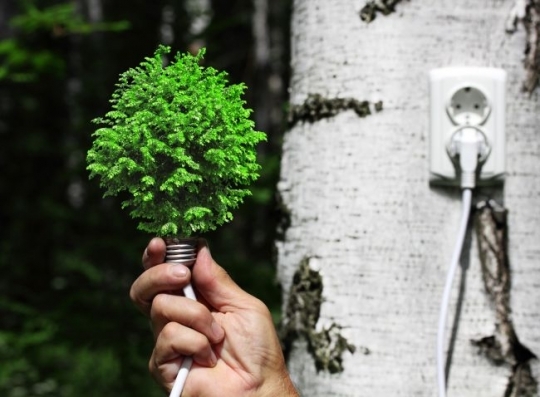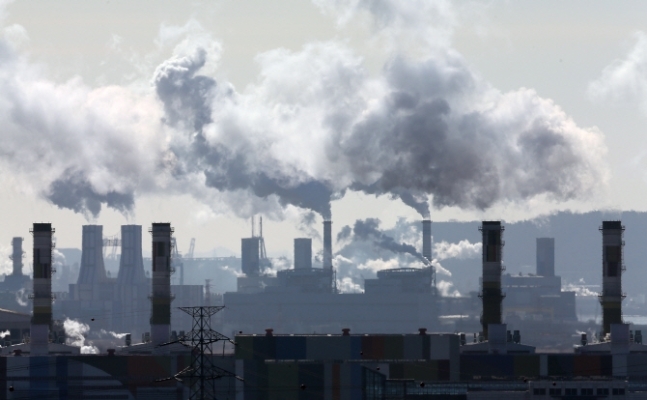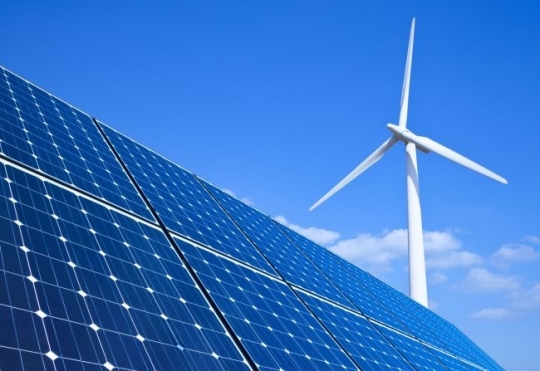The Korea Herald is publishing a series of articles looking into the South Korean government and businesses quest toward renewable energy. -- Ed.Four years since South Korea adopted its emissions trading scheme, the market appears to have soft-landed with the strong intervention of the government.
Emissions trading refers to the system where the government allocates permits to discharge specific quantities of pollutants over a given time period. Polluters that want to increase their emissions must buy permits from others willing to sell them.
To move to the next stage of a market-based scheme, companies should be more strategic in trading and more financial players should join the market, experts say.
In 2015, Korea adopted the emissions trading scheme as part of its efforts to achieve the climate goals of the Paris Agreement after much preparation under the Lee Myung-bak administration. He strongly pushed for green growth initiatives in line with the global trend at the time. Korea then set a goal of reducing annual projected carbon emissions in 2030 by 37 percent. This would leave CO2 emissions at some 550 million metric tons in 2030 from business-as-usual levels of some 850 million tons.

(123rf)
Korea, New Zealand and Kazakhstan and European countries have adopted emissions trading at a nationwide level. Some nations, including the US, Canada, China and Japan, have adopted the scheme at regional level. Other nations are trying other approaches, such as carbon taxes or penalties on pollutants.
In Korea, companies emitting more than 125,000 tons of greenhouse gases per year are obliged to join the scheme. Currently, there are around 600 companies affected, including Samsung Electronics, Hyundai Motor, LG Electronics, Posco and Hyundai Heavy Industries.
Better strategy, wider inclusion
Currently, the biggest problem in Korea’s emissions market is companies’ inability to deal with the short supply of permits, which results in a surge of prices. The price of emission permits, which started at some 8,000 won ($7) per ton in early 2015, has now jumped to more than 25,000 won.
Many companies with leftover permits do not sell them in the market because they are worried about future permit prices, industry prospects and potential changes in government policies on emissions trading and other uncertainties.
But, the biggest reason is that most of the companies have little understanding of emissions trading and how to strategically buy or sell permits, according to Lee Choong-kook, a chief of state-funded Korea Research Institute on Climate Change’s carbon emission center.
“Because CEOs and C-level leaders of most Korean firms have no understanding about what emissions trading is and why it is necessary, most of them lack expertise in emissions trading. They are unable to make a strategic plan.” Lee argued.
“They still consider emission permits as a sort of tax instead of company assets,” he added.
In order to make companies more strategic in trading, Shin Min-hee, a chief of the Korea Exchange’s emission trading division, said CEOs should make a “bold decision” about green goals at the company level.
“Look at Benz, BMW, Google, Facebook and Starbucks. They set goals of zero emissions at the company level and take a strategic approach to meet the goals. Unfortunately, not a single Korean company has set such a goal yet,” Shin said.
Globally, 154 companies, including BMW, Apple, Google and Facebook, joined RE100, a global campaign to make a commitment to go 100 percent renewable in offices, buildings and plants. No Korean company has joined RE100 yet.
But companies are not the only ones to blame, other experts say, pointing to how the government should also open the emissions market for more players to join that would further activate the trading.
At present, only the 600 companies covered by the scheme are able to trade their permits in the market, with no outside investors allowed.
“Imagine there is no foreign, institutional or individual investors in the Korean stock market. Trading will rarely take place. It’s the same thing in the emissions trading market. The market should be open to more players,” said Lee from the Korea Research Institute on Climate Change.
In Europe, which started the emissions trading in 2005, their financial institutions, such as banks and brokerage houses, account for 75 percent of all market players. They also make diverse financial products, such as exchange-traded funds, related to carbon emissions.
Possibly this year, the government will order three state-funded banks, Industrial Bank of Korea, Korea Development Bank and Export–Import Bank of Korea to stimulate the market as market makers -- acting as brokers.
The government is reviewing whether to bring more players to the market during the third phase (2021-2023). An official from the Environment Ministry said the market has been protected so far to make it arrive safe, but it seems time is rife for more players to join in order to galvanize the market.

(Yonhap)
Burden on heavy pollutersGoing green is certainly a global trend but it does not come without challenges.
Some industries -- steel, cement and petrochemicals -- feel more pain than others as they inevitably emit a lot of greenhouse gases.
Above all, the cement industry has been hit the hardest. During the first phase (2015 to 2017) of emissions trading scheme, they paid some 69 billion won to buy additional permits because the construction economy was unexpectedly thriving.
“The cement industry had to cut exports by more than half during the period because otherwise, they had to spend too much money on permits. If this continues, the industry will have to lose competitiveness against rivals in China, Taiwan and Japan,” said an insider at the cement industry, who asked for anonymity due to sensitivity of the subject.
The nation’s cement exports dropped from 9.5 million tons in 2014 to 3.4 million tons in 2017.
On top of the emissions permits, the cement companies are also to pay additional 65 billion won as a levy on the emissions of nitrogen oxide from next year. They may also have to pay additional 52.2 billion won per year if a revision on tax laws is passed to impose 1,000 won per ton of cement production.
Although steel and petrochemical industries have staved off such burden so far, they also have concerns as they will be required to make further cuts in emissions.

(123rf)
“We are making efforts to invest in facilities to reduce greenhouse emissions but the outcome of the investment does not come overnight and it takes years. But, the government seems to expect us to make a faster, bigger move,” said an anonymous insider from the steel industry.
Shin from the Korea Exchange acknowledged that the Korean government’s aim is a bit more ambitious compared to other countries, and it can be a burden to companies.
“It is still inevitable because giving companies pressure is the only way to move them,” Shin said.
Most recently on Feb. 26, Korean steelmaker Posco announced it plans to invest 1.07 trillion won in building environment-friendly facilities by 2021, with the aim of cutting air pollutants by 35 percent by 2022, in line with the government’s efforts to cut emissions of carbon dioxide.
Oh Hyung-na, a professor at Kyung Hee University, said in order to ease the burden falling on a few companies, green efforts should be made from all sectors.
“Going green is not a responsibility of only a few companies. Consumers should change their spending habits in favor of products made with less carbon emissions, companies should develop more eco-friendly technologies and the government should make the emissions trading market more transparent, stable and market-oriented,” Oh said.
By Shin Ji-hye (shinjh@heraldcorp.com)





![[Herald Interview] 'Amid aging population, Korea to invite more young professionals from overseas'](http://res.heraldm.com/phpwas/restmb_idxmake.php?idx=645&simg=/content/image/2024/04/24/20240424050844_0.jpg&u=20240424200058)


